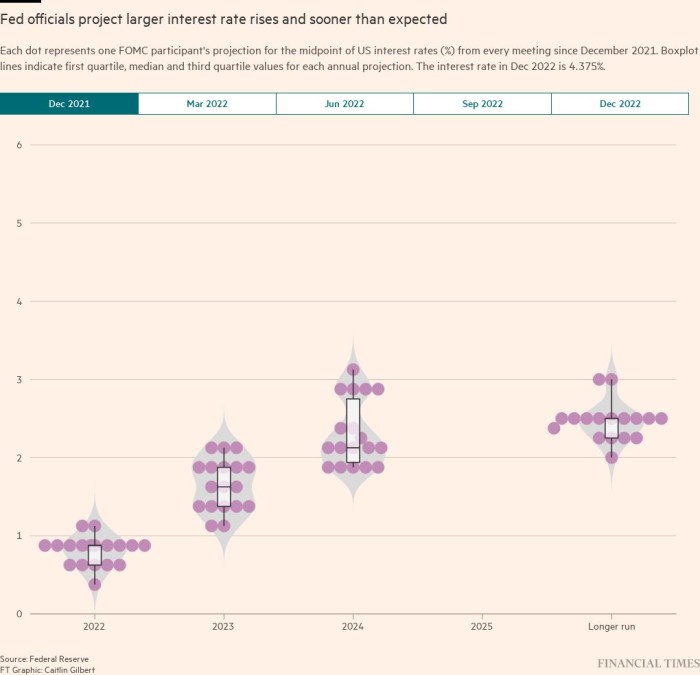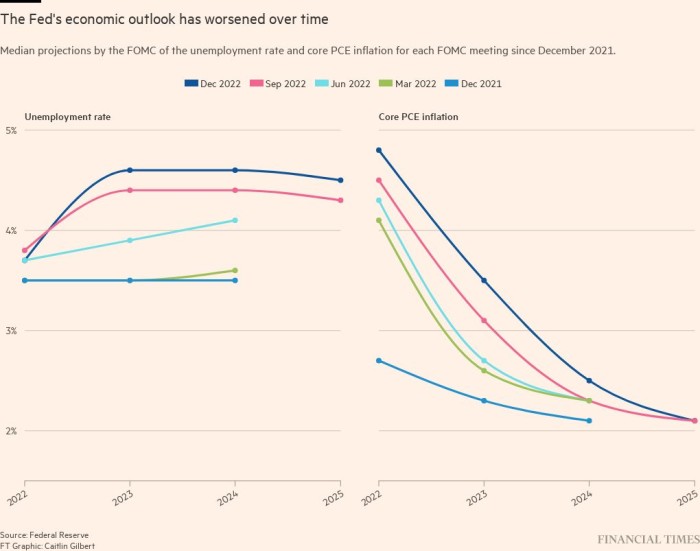The Federal Reserve raised its key policy rate by half a percentage point on Wednesday and signaled its intention to continue squeezing the US economy next year as central banks on both sides of the Atlantic enter a new phase. in the battle against inflation.
At its final meeting of the year, the Federal Open Market Committee voted unanimously to raise the federal funds rate to a target range of 4.25% to 4.5%, ending a string of months of rate increases of 0.75 percentage points.
The move to smaller rate hikes is likely to be followed internationally, with the European Central Bank and the Bank of England both set to raise borrowing costs by half a percentage point on Thursday.
Economists say inflation has peaked in all three regions, with key rate cuts in the US and UK this week, but central banks remain concerned it will take too long to reach their inflation targets. 2%.
In a press conference following the decision, Fed Chair Jay Powell said: “We have covered a lot of ground and the full effects of our rapid tightening so far have yet to be felt. We have other work to do.”
Powell welcomed the decline in core price growth in October and November but warned that “it will take much more evidence to give confidence that inflation is on a sustained downward path.”
In its statement, the Fed said that “continued hikes” in the policy rate would be “appropriate” to ensure it was constraining the economy enough to keep price growth in check.
As Powell spoke at his news conference, US stocks fell to session lows, with the S&P 500 down 0.8% and the Nasdaq Composite down 1%. The yield on two-year Treasuries, which moves with interest rate expectations, rose 0.03 percentage point to 4.2%.
Jay Barry, co-head of US rate strategy at JPMorgan, said investors had debated ahead of the decision whether the Fed would ditch the “continuous hikes” language in favor of something more accommodative.
Sticking to the phraseology “suggests there are more meetings away from the ongoing tightening cycle,” added Barry.
In parallel with the rate decision, the Fed released a revised “dot chart” of individual interest rate officials’ projections, which indicated support for further tightening next year.

The median estimate for the federal funds rate by the end of 2023 has risen to 5.1%, up from the 4.6% peak expected when the projections were last released in September. This suggests a total of 0.75 points of rate hike is yet to come.
Most officials now see the official rate falling to 4.1% in 2024 and 3.1% in 2025. That compares with 3.9% and 2.9%, respectively, three months ago.
However, Powell noted that Fed officials have steadily raised their forecasts for top interest rates and warned, “I can’t tell you for sure that we won’t be raising our estimate. . . still.”
Policymakers have raised their forecasts for inflation next year, with the median estimate for the basic personal consumption expenditure price index – their favorite inflation gauge – rising to 3.5%, compared with the 3.1% in September.
In 2024, most officials expect it to have fallen to just 2.5%, still above the central bank’s target. It is expected to drop to 2.1% the following year.
Reflecting officials’ expectations that they will need to compress the economy more than previously anticipated, policymakers have been more pessimistic about the outlook. The economy is projected to grow by just 0.5% in 2023 before registering a 1.6% expansion in 2024 when the unemployment rate will reach 4.6%.
In September, most officials forecast economic growth of 1.2% for 2023, followed by a 1.7% increase in 2024, with the unemployment rate reaching 4.4%.
The December meeting marks an important moment for the Fed, which this year embarked on its most aggressive attempt to tighten monetary policy since the early 1980s. As central bank actions have begun to have a major impact on the economy, a debate has emerged over how much more moderation is needed to tame inflationary pressures which remain high in many sectors.
Powell has previously said it will take “substantially more evidence” than just one month’s data for the central bank to be sure inflation is indeed coming down, noting past periods where better-than-expected data was followed by fresh increases.

US home prices are down from their recent peak as mortgage rates have risen, the manufacturing sector is sagging and consumer sentiment remains low.
However, the labor market continues to show resilience. The unemployment rate still hovers at a historically low 3.7% and wages have risen rapidly amid a severe shortage of workers, accelerating at a pace that officials warn is likely to trigger further price pressures.
Powell recently said it’s “very plausible” that the Fed could cut inflation without causing a recession. However, a new poll conducted by the Financial Times suggests doubts about that result. Of the economists surveyed, 85% expect a recession next year.